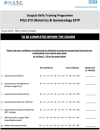Cadaveric surgery in core gynaecology training: a feasibility study
- PMID: 29386989
- PMCID: PMC5770503
- DOI: 10.1186/s10397-017-1034-0
Cadaveric surgery in core gynaecology training: a feasibility study
Erratum in
-
Correction to: Cadaveric surgery in core gynaecology training: a feasibility study.Gynecol Surg. 2018;15(1):5. doi: 10.1186/s10397-018-1038-4. Epub 2018 Feb 19. Gynecol Surg. 2018. PMID: 31329749 Free PMC article.
Abstract
Background: Fresh frozen cadaver training has been proposed as a better model than virtual reality simulators in laparoscopy training. We aimed to explore the relationship between cadaveric surgical training and increased surgical confidence.To determine feasibility, we devised two 1-day cadaveric surgical training days targeted at trainees in obstetrics and gynaecology. Seven defined surgical skills were covered during the course of the day. The relationship between surgical training and surgical confidence was explored using both quantitative (confidence scores) and qualitative tools (questionnaires).
Results: Participants rated a consistent improvement in their level of confidence after the training. They universally found the experience positive and three overarching themes emerged from the qualitative analysis including self-concept, social persuasion and stability of task.
Conclusions: It is pragmatically feasible to provide procedure-specific cadaveric surgical training alongside supervised clinical training. This small, non-generalisable study suggests that cadaveric training may contribute to an increase in surgical self-confidence and efficacy. This will form the basis of a larger study and needs to be explored in more depth with a larger population.
Keywords: Cadaveric surgery; Gynaecological surgery; Laparoscopy training; Surgical confidence.
Conflict of interest statement
Ethical consideration of the study was reviewed and approved from the Newcastle Clinical Research Facility. Informed consent was obtained from all participants included in the study.Consent to publish has been obtained from the participants.The authors declare that they have no competing interests.Springer Nature remains neutral with regard to jurisdictional claims in published maps and institutional affiliations.
Figures
References
-
- British Medical Association. What is the European working time directive?. https://www.bma.org.uk/advice/employment/working-hours/ewtd (Accessed 18 Sept 2016)
-
- The National Archives. General and specialist medical practice (education, training and qualifications) Order 2003.http://www.legislation.gov.uk/uksi/2003/1250/contents/made (Accessed 18 Sept 2016)
-
- Tooke J, Ashtiany S, Carter D, Cole A, Michael J, Rashid A, Smith PC, Tomlinson S, Petty-Saphon K. Aspiring to excellence: final report of the independent enquiry into modernising medical careers. http://www.asit.org/assets/documents/MMC_FINAL_REPORT_REVD_4jan.pdf (Accessed 18 Sept 2016)
-
- Wikipedia. Modernising medical careers. https://en.wikipedia.org/wiki/Modernising_Medical_Careers (Accessed 18 Sept 2016)
LinkOut - more resources
Full Text Sources
Other Literature Sources


